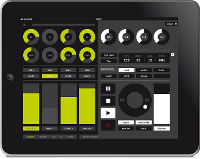iPad Music – First Impressions
Last month I got myself an iPad, justifying the purchase by its potential to perform the functions of such expensive controller hardware as Jazzmutant’s Dexter/Lemur, and more recently the ReacTable. But the big question was – would this magical multitouch device actually live up to the hype?
Enter The Tablet

Recent market research shows that the iPad has not been cannibalising PC sales (or, presumably, Mac sales), but has in fact created an entirely new product category. This is understandable since, as I discovered after purchasing my iPad in Dublin airport, you can’t even turn on the iPad until you connect it to a computer. Which has iTunes installed. Which must be itself connected to the Internet.
So it’s not exactly plug-and-play. The iPad is almost entirely dependent on iTunes, and is limited in many ways, so it is certainly not a substitute for a computer – it’s designed as a satellite device. But once you have it set up, it’s the app store that provides the key to its music making potential…
iPad Music – Hard Meets Soft
In terms of hardware, the multitouch interface is still the best out there – although competitors in this form factor are only now beginning to appear. Battery life is also very impressive – it would take one hell of a gig to drain an iPad. Interestingly, the iPad seems to consume practically no energy when in standby mode.
So far, the only time I’ve had issues with the hardware was when running iElectribe, which flashed up a low memory warning after recording some elaborate FX automation, but it still continued playback with no issues.
The hardware is clearly capable of providing a compelling music production/control experience; which leaves it up to the apps to deliver on that potential. So how do they stack up? Here are a few apps I’ve had a look at to date…
iPad Music – iElectribe
This is an app by KORG which eschews the idea of venturing into new realms of multitouch control, but instead provides a fairly faithful software emulation of a hardware beatbox classic.
I haven’t really delved into this in too much depth, but it is easy to use, good fun and has a lot of punchy sounds to play with. There are a selection of kits and synth sounds on offer, with built in effects, a tube overdrive emulation and step sequencer. Recording automation is a doddle, and everything is pretty much as you would expect from a hardware beatbox in terms of operation, although the software menus do make it easier to navigate sound banks than with the original box.
iPad Music – RJDJ Voyager
The RJDJ crew are definitely engaged with exploring new ways of processing and interacting with music; the RJDJ Voyager app is an interesting example of how various elements of a mix can be accessed and tampered with in a multitouch environment.
Touching the small circles activates or deactivates the instrument/effect; dragging it into the large centre circle creates linked circles that represent parameters for that instrument/effect. Moving these subcircles alters the parameters, generally increasing as you move them towards the centre of the ‘performance area’. This sort of interaction is reminiscent of the ReacTable, which has just been released as an app itself, and which I will definitely be trying out in the near future…
iPad Music – Loopseque
Another app trying to exploit new ways of interacting with music is Loopseque, a very user-friendly circular sequencer. It is colourful and interesting to watch, so may be good for live situations – you can switch between instruments and patches with quick sweeps of your hand, and the visual representations of patterns will appeal to many.
Unfortunately, there is as yet no capacity to load your own sounds into the app, but this will presumably be added in a later version.
iPad Music – TouchOSC
Now this is the app that allows Lemur-like DAW control from your iPad. I briefly tried it out as a controller for Ableton Live, and managed to get some sliders working after following the tutorial. On a PC, you’ll need to install two freeware programs before it will work – Pure Data Extended and MIDIYoke.
Although many of the music apps do currently have quite a toy-like feel to them, this area is probably where most musicians will see real potential. The customisation potential for multitouch control is endless, and although this implementation is still quite rough around the edges, I would expect to see things developing at a rapid rate in this area. The iPad does have quite a head start, but I’m sure Android tablets will be catching up in due course – it’s an interesting time ahead for multitouch music control…